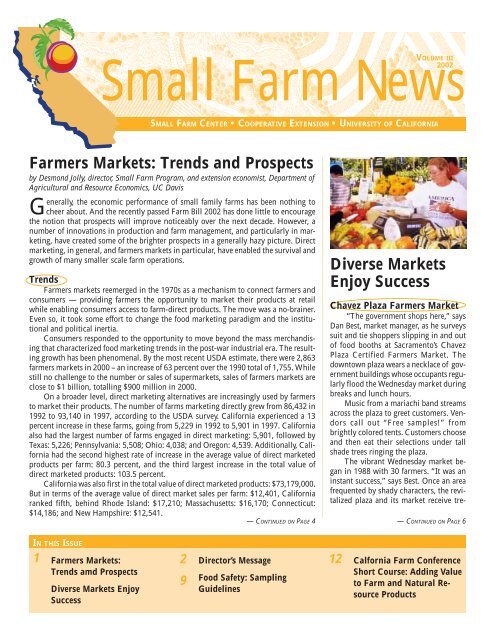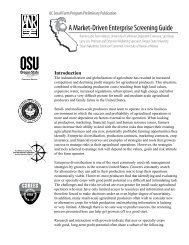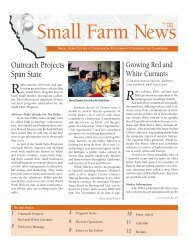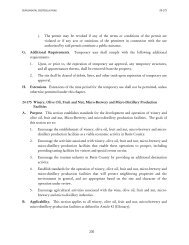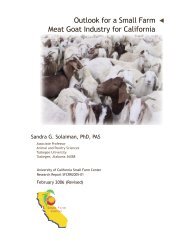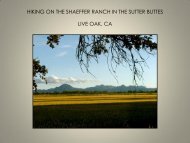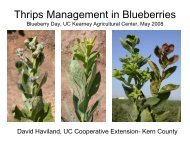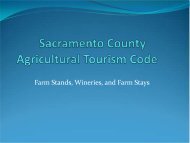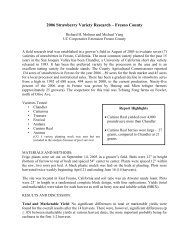Farmers Markets - University of California Small Farm Program - UC ...
Farmers Markets - University of California Small Farm Program - UC ...
Farmers Markets - University of California Small Farm Program - UC ...
You also want an ePaper? Increase the reach of your titles
YUMPU automatically turns print PDFs into web optimized ePapers that Google loves.
<strong>Small</strong> <strong>Farm</strong> NewsVOLUME III2002SMALL FARM CENTER • COOPERATIVE EXTENSION • UNIVERSITY OF CALIFORNIA<strong><strong>Farm</strong>ers</strong> <strong>Markets</strong>: Trends and Prospectsby Desmond Jolly, director, <strong>Small</strong> <strong>Farm</strong> <strong>Program</strong>, and extension economist, Department <strong>of</strong>Agricultural and Resource Economics, <strong>UC</strong> DavisGenerally, the economic performance <strong>of</strong> small family farms has been nothing tocheer about. And the recently passed <strong>Farm</strong> Bill 2002 has done little to encouragethe notion that prospects will improve noticeably over the next decade. However, anumber <strong>of</strong> innovations in production and farm management, and particularly in marketing,have created some <strong>of</strong> the brighter prospects in a generally hazy picture. Directmarketing, in general, and farmers markets in particular, have enabled the survival andgrowth <strong>of</strong> many smaller scale farm operations.Trends<strong><strong>Farm</strong>ers</strong> markets reemerged in the 1970s as a mechanism to connect farmers andconsumers — providing farmers the opportunity to market their products at retailwhile enabling consumers access to farm-direct products. The move was a no-brainer.Even so, it took some effort to change the food marketing paradigm and the institutionaland political inertia.Consumers responded to the opportunity to move beyond the mass merchandisingthat characterized food marketing trends in the post-war industrial era. The resultinggrowth has been phenomenal. By the most recent USDA estimate, there were 2,863farmers markets in 2000 – an increase <strong>of</strong> 63 percent over the 1990 total <strong>of</strong> 1,755. Whilestill no challenge to the number or sales <strong>of</strong> supermarkets, sales <strong>of</strong> farmers markets areclose to $1 billion, totalling $900 million in 2000.On a broader level, direct marketing alternatives are increasingly used by farmersto market their products. The number <strong>of</strong> farms marketing directly grew from 86,432 in1992 to 93,140 in 1997, according to the USDA survey. <strong>California</strong> experienced a 13percent increase in these farms, going from 5,229 in 1992 to 5,901 in 1997. <strong>California</strong>also had the largest number <strong>of</strong> farms engaged in direct marketing: 5,901, followed byTexas: 5,226; Pennsylvania: 5,508; Ohio: 4,038; and Oregon: 4,539. Additionally, <strong>California</strong>had the second highest rate <strong>of</strong> increase in the average value <strong>of</strong> direct marketedproducts per farm: 80.3 percent, and the third largest increase in the total value <strong>of</strong>direct marketed products: 103.5 percent.<strong>California</strong> was also first in the total value <strong>of</strong> direct marketed products: $73,179,000.But in terms <strong>of</strong> the average value <strong>of</strong> direct market sales per farm: $12,401, <strong>California</strong>ranked fifth, behind Rhode Island: $17,210; Massachusetts: $16,170; Connecticut:$14,186; and New Hampshire: $12,541.Diverse <strong>Markets</strong>Enjoy SuccessChavez Plaza <strong><strong>Farm</strong>ers</strong> Market“The government shops here,” saysDan Best, market manager, as he surveyssuit and tie shoppers slipping in and out<strong>of</strong> food booths at Sacramento’s ChavezPlaza Certified <strong><strong>Farm</strong>ers</strong> Market. Thedowntown plaza wears a necklace <strong>of</strong> governmentbuildings whose occupants regularlyflood the Wednesday market duringbreaks and lunch hours.Music from a mariachi band streamsacross the plaza to greet customers. Vendorscall out “Free samples!” frombrightly colored tents. Customers chooseand then eat their selections under tallshade trees ringing the plaza.The vibrant Wednesday market beganin 1988 with 30 farmers. “It was aninstant success,” says Best. Once an areafrequented by shady characters, the revitalizedplaza and its market receive tre-— CONTINUED ON PAGE 4 — CONTINUED ON PAGE 6IN THIS ISSUE1 2<strong><strong>Farm</strong>ers</strong> <strong>Markets</strong>:Trends amd ProspectsDiverse <strong>Markets</strong> EnjoySuccess9Director’s MessageFood Safety: SamplingGuidelines12Calfornia <strong>Farm</strong> ConferenceShort Course: Adding Valueto <strong>Farm</strong> and Natural ResourceProducts
SMALL FARM NEWS VOLUME III 2002Director’s MessageCelebrate <strong><strong>Farm</strong>ers</strong> <strong>Markets</strong>Desmond JollyWhen a few ‘back-to-the landers’organized a farmers market inDavis back in the mid-1970s, few <strong>of</strong> us,including the organizers, could haveimagined that it would become the centralcommunity institution that definesthe public face and character <strong>of</strong> the city.This is not to depreciate the communityvalue <strong>of</strong> one <strong>of</strong> the world’s bestpublic universities. But the public doesnot engage with the university the wayit does withthe farmersmarket.T h eDavis <strong><strong>Farm</strong>ers</strong>Markethas evolvedfrom ratherhumble beginnings— adozen farmersor so selling <strong>of</strong>f the backs <strong>of</strong> theirpickups along the sidewalk at the northwestcorner <strong>of</strong> Central Park.But like other products <strong>of</strong> a 1970scultural revolution against ‘WonderBread’ — natural foods, organic foods,herbal remedies, meditation, holisticmedicine and others — it tapped a responsivechord among consumers, particularlythe post-war 1960s generation.Recall that back in the ‘60s we were stillcaught in the web <strong>of</strong> a ‘meat and potatoes’Midwest cuisine. Even in <strong>California</strong>,iceberg lettuce was de riguer.Above and right: Shoppers stroll and a chefprepares a meal at the Davis <strong><strong>Farm</strong>ers</strong> Market.It was the ‘back-to-the landers,’ thesmall scale, pioneer farmers <strong>of</strong> the ‘70sand ‘80s, who created the perception thatproduce could be exciting, and farmersmarkets came to be associated with freshness,with flavor, with a wholesomenessthat seemed attractive compared with thesupermarket choices <strong>of</strong> gas ripened tomatoes,immature fruit, and iceberg lettuce.We should note that today’s supermarketbears little resemblance to the supermarkets<strong>of</strong> the ‘60s. They haveadapted, and in so doing, have incorporatedmany <strong>of</strong> the attributes <strong>of</strong> farmersmarkets. So all consumers are now beneficiaries<strong>of</strong> the innovations developed by<strong>California</strong>’s small farmers.Even so, farmers markets continueto grow in popularity for a variety <strong>of</strong>reasons, including the atmosphere.And absent this growth, small scalefarming would be inconsequential inour agricultural landscape. So celebratewith us, in this season <strong>of</strong> abundantproduce, the birth and growth <strong>of</strong><strong>California</strong>’s and the U.S.’s farmers markets.P.S. Added Value ProductsOur next issue <strong>of</strong> <strong>Small</strong> <strong>Farm</strong>News will be devoted to added valueproducts. If you are involved with theproduction and marketing <strong>of</strong> addedvalue products, we might list your farmand products in an added value directorywe will be developing.For more information, contact the<strong>Small</strong> <strong>Farm</strong> Center at (530) 752-8136,or e-mail: sfcenter@ucdavis.eduVisit the <strong>Small</strong> <strong>Farm</strong> Center's online library athttp://www.sfc.ucdavis.edu/libraryto order small farm publications on topics ranging fromadzuki beans to agricultural legislation.2
VOLUME III 2002SMALL FARM NEWSprogram newsVisitorsMembers <strong>of</strong> the AgriculturalDevelopmentProject for India visitedwith Desmond Jolly recentlyat the <strong>Small</strong> <strong>Farm</strong>Center. From various regions<strong>of</strong> India, membersinclude Paramajit SinghBal, farmer and managingpartner <strong>of</strong> Nasirpur <strong>Farm</strong>Products; Seema Bathla,agricultural economist,Dehli <strong>University</strong>; Shalini Kala, program <strong>of</strong>ficer,World Food <strong>Program</strong>; Parmod Kumar, economist,National Council <strong>of</strong> Applied EconomicResearch; Ashok Kundu, senior research fellow,<strong>University</strong> <strong>of</strong> Kalyani; Milind Murugkar, assistantpr<strong>of</strong>essor, K.K. Wagh College <strong>of</strong> Engineering;and Saleem Sultan, owner <strong>of</strong> Sultan ColdStorage, Uttar Pradesh.The seven-member Agricultural Development Project forIndia visited the <strong>Small</strong> <strong>Farm</strong> Center this summer.WelcomeJan Mickler joins <strong>UC</strong> Cooperative Extension,Stanislaus County, as the new vegetablecrops advisor. She recently completed her doctoralprogram in plant pathology at the <strong>University</strong><strong>of</strong> <strong>California</strong>, Riverside, and brings a wealth<strong>of</strong> plant pathology experience to the vegetablecrops industry in Stanislaus County.<strong>UC</strong> Cooperative Extension, Santa CruzCounty, welcomes new strawberry and caneberryadvisor Mark Bolda, whose assignment also coversMonterey and San Benito counties. Boldacomes from private industry with six years’ experiencein berry research and production. Heholds a master’s degree in plantprotection and pest managementfrom <strong>UC</strong> Davis.<strong>Small</strong> <strong>Farm</strong> <strong>Program</strong>workgroup member PaulVossen, a farm advisor with <strong>UC</strong>Cooperative Extension, SonomaCounty, has returned from sabbaticalleave in Cordoba, Spain,where he spent 10 monthsstudying olive oil production,processing and evaluation. Heis developing three publications based on his researchin Spain..GrantsThe <strong>Small</strong> <strong>Farm</strong> Center won a USDA RiskManagement Agency (RMA) Risk ManagementGrant for $90,000 to develop a risk managementeducation project.Presentations<strong>Small</strong> <strong>Farm</strong> <strong>Program</strong> director Desmond Jolly,farm advisor Mark Gaskell, <strong>UC</strong> Cooperative Extension,San Luis Obispo and Santa Barbara counties,and <strong>Small</strong> <strong>Farm</strong> <strong>Program</strong> workgroup memberTrevor Suslow, extension specialist, presentedworkshops at the Third National <strong>Small</strong> <strong>Farm</strong> ConferenceSeptember 17-20, 2002, in Albuquerque,New Mexico.<strong>Small</strong> <strong>Farm</strong> <strong>Program</strong> farm advisor RamiroLobo, <strong>UC</strong> Cooperative Extension, San DiegoCounty, attended the National Extension TourismConference September 16-19, 2002, in TraverseCity, Michigan.<strong>Small</strong> <strong>Farm</strong>CenterSMALL FARM NEWS is published by the <strong>Small</strong> <strong>Farm</strong>Center, <strong>University</strong> <strong>of</strong> <strong>California</strong>, One Shields Avenue,Davis, CA 95616-8699 • phone: (530) 752-8136fax (530) 752-7716 • e-mail: sfcenter@ucdavis.eduweb site: http://www.sfc.ucdavis.eduDirector: Desmond Jolly, dajolly@ucdavis.eduAdministrative Asst.: Linda Vieira, lmvieira@ucdavis.eduAdministrative Asst.: Birgit Hempel, sfcenter@ucdavis.eduContributing Editors: Jamie Anderson and Gillian BradyEditor/Designer: Susan McCue, semccue@yahoo.comTechnical Asst.: Solomon Teklu, steklu@ucdavis.eduStudent Asst.: Samuel TetThe <strong>Small</strong> <strong>Farm</strong> Center links those who need informationon small-scale farming with those who have the information.The Center produces publications and a newsletter;sponsors conferences and seminars; holds a library <strong>of</strong>periodicals, reports and books; gives referrals; and answersnumerous requests for information.Readers are encouraged to send us information, expressviews, and contact us for assistance. Mention <strong>of</strong> a specificproduct is intended for the reader’s information or as anexample <strong>of</strong> a similar product—not as a recommendation <strong>of</strong>that specific product.3
SMALL FARM NEWS VOLUME III 2002<strong><strong>Farm</strong>ers</strong> <strong>Markets</strong> – FROM PAGE 1While <strong>California</strong> has experienced tremendousgrowth in the direct marketing<strong>of</strong> farm products, the per farm figures forRhode Island and Massachusetts point toeven greater possibilities for direct marketing<strong>of</strong> <strong>California</strong> farm products.Policy and Institutional SupportThe bulk <strong>of</strong> the credit for farmersmarkets as a marketing innovation shouldaccrue to those farmers and consumeradvocates who initiated policy and institutionalchanges that opened the way.Legislative members in some cases had tobend the rules regarding areas such asstandard packs, and we know how difficultit can be to turn the battleship even afew degrees. Nonetheless, in <strong>California</strong>and elsewhere, legislation gave legal statusto farmers markets while codifying theterms and conditions for certification.These conditions include who can sellproduce at a farmers market, and the prohibitionsregarding resale <strong>of</strong> produce.More recently, certification has come torequire inspections <strong>of</strong> production plots tocertify that farmers actually grow or arecapable <strong>of</strong> producing what they sell.Early on, in the late 1970s and early1980s, the <strong>California</strong> Department <strong>of</strong> Foodand Agriculture (CDFA) deployed a cadre<strong>of</strong> staff to provide technical assistance tobeginning markets and to oversee marketgrowth and performance. Fiscal constraintshave reduced the ability <strong>of</strong> CDFAto <strong>of</strong>fer the same level <strong>of</strong> technical assistanceit earlier afforded, although it stillmaintains ultimate responsibility for administrativeand legal enforcement <strong>of</strong>regulations. The CDFA delegates manyenforcement responsibilities to the countybased agricultural commissioners.By the 1990s, the farmers marketphenomenon was no longer regarded asa sideshow, an indulgence <strong>of</strong> elite foodconscious yuppies. For thousands <strong>of</strong> familyscale farmers, it had become the mainevent. USDA began to take notice <strong>of</strong> theexistence <strong>of</strong> farmers markets and theircontributions to farm income, and consumerdemand for farm fresh foods and a‘high-touch’ relationship to their foodsources. Former USDA Secretary DanGlickman launched farmers markets outsidethe USDA building in Washington,and he and former Deputy Secretary RichardRominger participated in many highpr<strong>of</strong>ile publicity events to highlight andpr<strong>of</strong>ile farmers markets and to move themmore into the mainstream <strong>of</strong> the foodmarketing system.USDA’s Agricultural Marketing Servicebegan to allocate more effort awayfrom their traditional emphasis on brickand mortar markets and towards farmersmarkets. USDA sponsored farmers marketconferences in various parts <strong>of</strong> thecountry, such as one in Santa Fe, NewMexico. USDA also cooperated withCornell <strong>University</strong> in a project that usedfocus groups to identify issues and needs<strong>of</strong> farmers market stakeholders in 10Northeast and Mid-Atlantic states. Theyalso sponsored a session held in conjunctionwith the North American <strong>Farm</strong> DirectMarketing Association conference inGrand Rapids, Michigan, in January 2000.USDA also has set up the <strong><strong>Farm</strong>ers</strong>Market Hotline with an 800 number (1-800-384-8704) that provides logisticalinformation on markets, and has producedthe National Directory <strong>of</strong> <strong><strong>Farm</strong>ers</strong><strong>Markets</strong> in 1996 and 1998. The agencyalso has conducted periodic surveys <strong>of</strong>farmers markets, and is involved in a cooperativeagreement with the <strong>UC</strong> <strong>Small</strong><strong>Farm</strong> Center to produce a farmers marketpr<strong>of</strong>essional development trainingprogram.Patronage <strong>of</strong> <strong>Markets</strong>Customer demographics at farmersmarkets indicate a predominantly highincome, highly educated, and not veryethnically diverse clientele. In his study<strong>of</strong> 21 farmers markets in San DiegoCounty in 1998, <strong>Small</strong> <strong>Farm</strong> <strong>Program</strong><strong>Farm</strong> Advisor Ramiro Lobo found the followingwith regards to customer demographicpatterns: 76 percent were female;88 percent were more than 36 years old;56 percent had at least a four year collegedegree; 82 percent identified themselvesas white; 24 percent earned less than$40,000; 30 percent earned between$40,000 and $60,000; 35 percent earnedmore than $80,000; and 14 percent earnedmore than $100,000.Rutgers <strong>University</strong> extension specialistRamu Govindasamy’s 1998 New Jerseystudy found that 84 percent <strong>of</strong> farmersmarket consumers identified themselvesas white; 88 percent were older than36 years; and 54 percent were older than51 years. Similarly to the Lobo San Diegostudy, the New Jersey study indicated that83 percent were women, but 68 percenthad no children living in the household.Regarding educational level, 62 percenthad a college degree, and 55 percent hadhousehold incomes <strong>of</strong> more than $60,000.Another 24 percent earned between$40,000 and $60,000, and 21 percent hadincomes less than $40,000.In his 2000 national survey, EconomistTim Payne <strong>of</strong> the USDA AgriculturalMarketing Service found that customersspent an average <strong>of</strong> $17.30 per week inthe national survey compared with $19.25in the San Diego survey and $16 in theNew Jersey survey. Payne notes that twothirds<strong>of</strong> customers live within 10 miles<strong>of</strong> the market and are motivated to buylocal products.Impacts on VendorsGovindasamy’s study <strong>of</strong> producers atNew Jersey’s farmers markets was basedon a relatively small sample <strong>of</strong> 36. Nonetheless,the results suggest the potentialfor enhancing sales <strong>of</strong> family farms. A reported43 percent sold over $100,000, and39 percent sold less than $15,000. <strong><strong>Farm</strong>ers</strong>utilized other marketing channels aswell. For 40 percent <strong>of</strong> the farmers, salesfrom farmers markets provided 20 percentor less <strong>of</strong> their incomes; 30 percent earnedfrom 25 – 40 percent <strong>of</strong> their income; and34 percent (approximately one-third)from 50 – 100 percent <strong>of</strong> their income.Growing PainsAs with organic foods, farmers marketshave become a trendy, hip thing, andas with organic foods, the trendy, hip thingis fraught with potential problems.4
VOLUME III 2002SMALL FARM NEWSWhereas the original motive for certifiedfarmers markets was to enhance the performance<strong>of</strong> small farmer marketing byproviding a direct avenue to consumers,motivations for starting a farmers markethave become much more diverse.For example, agencies involved inurban redevelopment see farmers marketsas another tool to revitalize central cities;food security advocates see them as amethod <strong>of</strong> providing low income householdswith access to farm-fresh, nutritiousfoods, and innovative entrepreneurs seethese markets as a pr<strong>of</strong>it making opportunity,and some are not certified farmersmarkets. The blurring <strong>of</strong> purpose can leadto a disjunction between the welfare <strong>of</strong>farmers and the interests <strong>of</strong> the market’ssponsors or operators. Even in the case<strong>of</strong> certified farmers markets, which predominatein <strong>California</strong>,there is evidence thatthe interests <strong>of</strong> marketmanagement and interests<strong>of</strong> small familyscale farmers are not alwaysin total alignment.Thus, a significantemerging challengeis the clarification<strong>of</strong> the purposes <strong>of</strong>farmers markets andthe optimization <strong>of</strong> theinterests <strong>of</strong> family scalefarmers, consumers,communities and marketmanagement.In his 2000 national survey, Paynefound that 63 percent <strong>of</strong> farmers marketshad vendor-operated boards <strong>of</strong> directors;18 percent were operated by governmentorganizations, and 42 percent were runby non-pr<strong>of</strong>its.In another study by Govindasamy inNew Jersey, 4 percent <strong>of</strong> a sample <strong>of</strong> 24market managers or operators reportedthat they were self-employed, 37.5 percentwere employed by a city, townshipor county; 29.2 percent were employedby markets, chambers <strong>of</strong> commerce ornon-pr<strong>of</strong>its; and 29 percent were volunteers.A vendor rearranges fruit at a<strong>California</strong> farmers market.With this diversity in structure, purposeand governance, one would reasonablyexpect that the performance <strong>of</strong> marketswould be quite variable. In the NewJersey study, 83 percent <strong>of</strong> managers whoresponded to the study had no farmingexperience. This might lead to the disjunctionwe alluded to earlier between theinterests <strong>of</strong> management and the interest<strong>of</strong> farmers.The Issue <strong>of</strong> Integrity<strong><strong>Farm</strong>ers</strong> markets, particularly “certified”farmers markets, present a set <strong>of</strong>product attributes to customers that goesbeyond the produce per se. <strong><strong>Farm</strong>ers</strong> marketspurport to sell farm-direct products,with exceptions for some non-farm productsallowed into the market. The datafrom consumer surveys indicates that consumersperceive the farmdirectproducts as denotingfreshness and quality. Moreover,many consumers wantto support family farmers.But enforcement <strong>of</strong> thisdictum <strong>of</strong> farm producedproducts sold by farmers isproving problematic, andthe issue <strong>of</strong> market integrityhas consumed substantialenergy, and generated muchanguish amongst marketmanagers, farmers, vendors,agricultural commissionersand CDFA. In <strong>California</strong>, farmers musthave their production certified and shouldhave a list <strong>of</strong> products on their certificate.They are allowed to sell products on behalf<strong>of</strong> one other certified producer. Butthere is much talk, if not documentation,<strong>of</strong> vendors reselling products not producedon their farms.CDFA has proposed a schedule <strong>of</strong>penalties for various violations, with finesranging from $50 for minor infractionsto $1,000 for more serious ones. But theability to enforce these regulations is inquestion. Agricultural commissioners,who comprise the second line <strong>of</strong> defenseafter market managers, have a substantialworkload, and farmers markets areonly one component <strong>of</strong> their responsibilities.And an increased level <strong>of</strong> administrativefatigue appears to be emerging.To the extent that farm-direct is a keyattribute for consumers to patronize farmersmarkets, and to the extent that directmarketing is a key method <strong>of</strong> improvingthe performance <strong>of</strong> family scale farms, theissue <strong>of</strong> reselling is not trivial and continuesto warrant concentrated attention.Given the administrative constraints derivingfrom budgetary and resource limits,markets will have to develop supplementarymeans <strong>of</strong> maintaining marketintegrity. This will require a more cohesiveand coordinated strategy amongst theseveral hundred markets in <strong>California</strong>.The Southland <strong><strong>Farm</strong>ers</strong> MarketAssociation’s Code <strong>of</strong> Ethics provides atemplate for self-governance as a complementto the CDFA enforcement system.Southland’s Value Statement also clearlyoutlines what consumers can expect anddemand from their member markets, andin turn, what farmer-vendors and communitiescan expect from Southland markets.ProspectsThere clearly is a valued niche forfarmers markets in the food distributionsystem, as indicated by the robust rate <strong>of</strong>growth during the past 20 years, and inthe equally impressive geographic spreadacross the urban and rural landscape.Consumers identify farmers markets witha number <strong>of</strong> positive attributes. In fact,large numbers <strong>of</strong> supermarkets have developedproduce merchandising systemsthat mimic, to the extent possible, farmersmarkets. But with growth comes challenges.The farmers market system hasreached a level that demands higher levels<strong>of</strong> management, greater coordinationand more effective governance. Some <strong>of</strong>the spontaneity may be lost in this process,but what may be gained issustainability and high levels <strong>of</strong> customersatisfaction. One would have to judge theprospects for continued growth as bright,providing that the challenges are met in atimely, forthright manner.5
SMALL FARM NEWS VOLUME III 2002Diverse – FROM PAGE 1mendous support from the surroundingcity organizations, government agencies,and local vendors who credit the marketwith reinvigorating the area.Now 40 to 50 farmers pack the marketduring peak season. Shoppers can pickfrom a dazzling variety <strong>of</strong> <strong>of</strong>ferings, fromfresh rhubarb to flaming red tomatoes.“We try to break up commodities to createcustomer movement,” says Best.As for findingnew vendors,Dan Bestsays, “We’re intor eplacementmode, not recruitmentmode.”When afarmer leavesthis market,Best turns toother farmers inthe nine marketSacramentoCertified <strong><strong>Farm</strong>ers</strong> Market system that hemanages to find the needed commodity.Before managing the market system, Beststarted out as one <strong>of</strong> its first farmers, sellingcorn, tomatoes, and bell peppers fromhis family’s farm in Lodi.A <strong>Farm</strong>er’s Perspective“I’ve got a loyal cult following,” saysTony Mora <strong>of</strong> Mora Family <strong>Farm</strong>s inDenair, <strong>California</strong>. “It’s the people whoreally want good fruit,” explains Mora,who says his farmers market customerskeep coming back even though “I’vecharged $1.50 a pound for 10 years.”Mora’s family grows 57 acres <strong>of</strong>peaches, plums and nectarines that theysell at 35 or 40 markets a week in the BayArea and Sacramento regions. Gross salesfluctuate, says Mora. As for customersales, at this market Mora says he hasplenty <strong>of</strong> one-pound customers. “We’rehustling for a buck,” says Mora. “Thelunch crowd …want one peach for dessert.”His goal is to raise customer spendingto $3 each, and to that end, he’splanted 19 different stone fruit varieties.“Variety is the key,” says Mora. “Peoplebuy more then.”One <strong>of</strong> those people is Susan Rose,who walks to the market every Wednesdayfrom her federal government jobacross the street. “I like to help out thesmall farmer, because I know how hard itis for them to make ends meet,” Rose says.“It’s well publicized how hard it is to keepthe small farm alive these days.”Market vegetables glow with health; Dan Best getsmarket help from his daughter Angela Allen; andRenae Best discusses mustard greens with a vendor.On-site Education <strong>Program</strong>Before Renae Best started her farmersmarket education program, some <strong>of</strong>the children “didn’t even know what apeach was,” she says. Best and her husbandDan had managed farmers marketsin Sacramento’s low income areas for yearswhen she decided to develop an educationalprogram to teach children aboutfresh fruits and vegetables.Begun in 1996, her program linksfarmers markets with fourth grade studentsin Sacramento and Elk Groveschools. Area farmers markets serve asBest’s lively outdoor classroom. As manyas three classes a day and 34 students at atime pour <strong>of</strong>f the bus to start their lessons.After her introduction, Best sendsthem <strong>of</strong>f with worksheets they must fillout “like a scavenger hunt. It’s all aboutthe nutritional value <strong>of</strong> the food that’s inthe market.”The children also tally the number <strong>of</strong>farmers from each <strong>California</strong> county byreading the farm banners posted in eachstall. When the worksheets are complete,students trade them for a market tokenworth 25 cents. “Sometimes the little girlsput their tokens together to buy flowersfor their mom,” says Best.This fall, Best launches a new programat Sacramento’s Cal Expo. Studentsvisiting its demonstration farm will thentour the new Cal Expo <strong><strong>Farm</strong>ers</strong> Market.“They can see it in the field and on thetable,” says BestCameronP a r k<strong>Farm</strong>er’sMarketT h eCameron Park<strong><strong>Farm</strong>ers</strong> Marketin El DoradoCounty is onlyin its secondyear <strong>of</strong> existence,but has alreadygained aloyal group <strong>of</strong>vendors and customers. Alauna Bray, whosold her famous garlic and heirloomPomodoro tomatoes at other area marketsfor eight years, was determined to makethe market a reality. Last year, she gathereda small group <strong>of</strong> growers to sell theirproduce at the market just weeks beforeit opened. Due to last year’s success, thisyear’s market boasts a variety <strong>of</strong> products,from seasonal farm produce and fresh cutflowers to organic olive oil and freshbaked bread.“Selling at the market is the mostwonderful thing I have ever done in myentire life,” says Bray. “It’s fun, and youget to know people.”The Cameron Park location was chosenbecause the area, east <strong>of</strong> Sacramento,is growing so rapidly. Located on a parkinglot between the grassy picnic area andchildren’s playground at Christa McAuliffePark, the market is held on Wednesdaysand Saturdays and provides an ideal locationfor family outings.Unlike other area markets with longwaiting lists, this market is looking for additionalvendors for next year. While lo-6
VOLUME III 2002SMALL FARM NEWScal farmers have a good variety <strong>of</strong> highquality produce, the shorter growing seasonin El Dorado County prohibits themfrom providing a steady supply throughthe fall season. So the market has openedits space to outside vendors, and has agrower coming from Fresno and two familiesbringing Asian vegetables from SacramentoCounty.“We will continue to expand andbring in vendors from outside <strong>of</strong> ElDorado County,” says Donna Sauber, markettreasurer. “Consumers want cherriesall summer, when they are only ripe for afew weeks locally.”Customersalso like the variety<strong>of</strong> productsbeing broughtin by the out-<strong>of</strong>towngrowers.Market managerAlan Clarke sayseducating theconsumer issomething farmersmarkets dowell. In August, one <strong>of</strong> the vendors friedokra to demonstrate how it can be preparedwithout the so-called “sliminess”many people dislike. Growers also talk totheir customers about how the produceis grown and harvested. Many growersalso provide printed recipes for the lesscommonly known Asian vegetables.Alauna Bray is already working onher list <strong>of</strong> vendors for next year’s market.Interested farmers can reach her at (530)676-3509.Ferry Plaza <strong><strong>Farm</strong>ers</strong> MarketTwice a week along the San FranciscoBay, an unremarkable urban corner blossomsinto a colorful market. Every Tuesdayand Saturday, producers and vendorsarrive, the white tents go up, and 5,000to 8,000 shoppers sample, purchase, andeat their way through the Ferry Plaza<strong><strong>Farm</strong>ers</strong> Market.This bustling market in downtownSan Francisco, coordinated by the Center<strong><strong>Farm</strong>ers</strong> market scenes include this green hairedvendor, fresh rhubarb, and Tony Mora at his fruit stand.for Urban Education about SustainableAgriculture (CUESA), opened on a Saturdayin May 1993 and has been held eversince. Many <strong>of</strong> the farmers who squeakedthrough its first lean year, barely makingenough money for gas, are still there today.Now they consider this their mostsuccessful market.The Saturday Ferry Plaza <strong><strong>Farm</strong>ers</strong>Market brings 80 producers — farmers,fishermen and women, flower and plantgrowers, and cheese makers — and 20vendors — bakers, local restaurants, ac<strong>of</strong>fee cart, and chocolate makers — togetheron a parking lot at Embarcaderoand Green.“It’s a delicate balance in the market.We try to make sure we have enough <strong>of</strong>everything, but not too much,” saidTatiana Graf, CUESA’s communicationsmanager.According to Steve Clemens, marketmanager, “The big things that people likeabout our market are the quality <strong>of</strong> theproduct, the mix <strong>of</strong> products, and thegrower participation.”This informal educational exchangebetween growers and customers has beena signature <strong>of</strong> the Ferry Plaza Market, andpart <strong>of</strong> what makes shoppers so dedicatedto their favorite sellers.Through the “Meet the Producer andShop with the Chef” event, CUESA connectsfar-flung producers and urban chefsevery Saturday from April to November.Sixty attentive shoppers sit around anoutdoor kitchen to hear a producer describehow they grow or make the featureditem, and then watch a chef prepare it.After the cooking demonstration, thecrowd samples the dish and gets a copy<strong>of</strong> the recipe.These regular shoppers are the heart<strong>of</strong> the Ferry Plaza Market. Producers describethem as consistent, loyal, and veryknowledgeable about food. They are thetrue San Francisco “foodies.” Characterizedby an appreciation for fresh, highqualityfoods, gourmet dishes, and newflavors, foodies trek to the market in anyweather — rain, shine, or fog — for theirweekly purchases. And they turn out inlarge numbers,pushingthe marketto nearcapacity.“Rightnow, even ifwe had amarketingbudget, weprobablywouldn’twant to useit becauseit’s so crowded already,” says managerClemons.Despite the crowds, public transportationto the market is very limited. Sinceonly one railcar stops nearby, an estimated60 - 70 percent <strong>of</strong> shoppers drive there.This makes parking a hassle and severelylimits the customer base.In spring 2003, the Ferry Plaza <strong><strong>Farm</strong>ers</strong>Market will move three blocks downEmbarcadero into the newly remodeled,historic Ferry Building. The Ferry Buildinghas much better access to public transportation,which will make the market accessibleto a much broader audience.Article authors: Jamie Anderson, graduateassistant, and Gillian Brady, programrepresentative, <strong>Small</strong> <strong>Farm</strong> Center, andSusan McCue, editor. Photography: JamieAnderson and Susan McCue.7
SMALL FARM NEWS VOLUME III 2002publicationsresourcesweb sitesControlling the Chaos: Suggested Guidelines for Implementation and Management<strong>of</strong> a Retail <strong><strong>Farm</strong>ers</strong> Market provides detailed information fromthe Economics Institute at Loyola <strong>University</strong> New Orleans, the organizationthat runs the city's Crescent City <strong><strong>Farm</strong>ers</strong> Market. Cost: $30 plusshipping and handling. Contact: Loyola Twomey Center, 7214 St. CharlesAve., Box 907, New Orleans, LA 70118; Crescent City <strong><strong>Farm</strong>ers</strong> Market:(504) 861-5898, or online at http://www.crescentcityfarmersmarket.com/markets/merchandise.php.Starting and Strengthening <strong><strong>Farm</strong>ers</strong>’ <strong>Markets</strong> in Pennsylvania, Second Edition is astraightforward guide that provides tips on launching a market and maintaining it withorganizational and marketing tools. Cost: Free. Contact: The Center for Rural Pennsylvania,200 North Third Street, Suite 600, Harrisburg, PA 17101; (717) 787-9555.<strong><strong>Farm</strong>ers</strong> <strong>Markets</strong>: Consumer Trends, Preferences and Characteristics is produced byRutgers <strong>University</strong> in New Jersey and focuses on the state’s farmers markets. The 38-page report includes demographics, consumption trends <strong>of</strong> fresh fruits and vegetables,preferences for organic produce, and amount spent per visit. Cost: Download is freefrom http://aesop.rutgers.edu/~agecon/agmkt.htm. Contact: Ramu Govindasamy,Rutgers, The State <strong>University</strong> <strong>of</strong> New Jersey, 55 Dudley Rd., New Brunswick, NJ 08901-8520; (732) 932-9171 ext. 25.Other related resources at this Rutgers web site include <strong><strong>Farm</strong>ers</strong>’ <strong>Markets</strong>: ManagersCharacteristics and Factors Affecting Market Organization, and <strong><strong>Farm</strong>ers</strong>’ <strong>Markets</strong>:Producers’ Characteristics and Status <strong>of</strong> Their Business.<strong><strong>Farm</strong>ers</strong> <strong>Markets</strong> and Rural Economic Development: Entrepreneurship, <strong>Small</strong> BusinessIncubation and Job Creation in the Rural Northeast provides insights for farmersmarket sponsors, extension staff and economic development <strong>of</strong>ficials about how farmersmarkets contribute to local economic development. Cost: $4.25. Contact: <strong>Farm</strong>ingAlternatives <strong>Program</strong>, Cornell <strong>University</strong>, Ithaca, NY 14853; (607) 255-9832; http://www.cals.cornell.edu/agfoodcommunity/afs_ld.cfmU.S. <strong><strong>Farm</strong>ers</strong> <strong>Markets</strong> 2000: A Study <strong>of</strong> Emerging Trends provides detailed informationincluding market management structure, total number <strong>of</strong> vendors, and averagecustomer spending. Cost: Download is free at http://www.ams.usda.gov/directmarketing/publications.htm. Contact: Velma Lakins, Marketing Services Branch, USDA, Room2644 South, 1400 Independence Ave. S.W. Washington, D.C. 20250-0269; no phonenumber available; fax number: (202) 690-0031; or web site above.Trends in Agricultural Land and Lease Values for 2002 is a report published by the<strong>California</strong> Chapter <strong>of</strong> the American Society <strong>of</strong> <strong>Farm</strong> Managers and Rural Appraisers.The report shows that <strong>California</strong>’s Central Coast land values have remained largely thesame since the year 2000. For report details, visit the society’s web site at http://www.asfmra.org/fsitemap.htmNEW FARMERS MARKET RESOURCESForthcoming <strong>UC</strong> <strong>Small</strong> <strong>Farm</strong> Center/USDA farmers market publications include Startinga <strong><strong>Farm</strong>ers</strong> Market; <strong><strong>Farm</strong>ers</strong> Market Management: Management Skills for <strong><strong>Farm</strong>ers</strong>Market Managers; and Growing Your Market. Publication is expected in early2003. For details or to be added to the waiting list, contact the <strong>Small</strong> <strong>Farm</strong> Center at(530) 752-8136 or e-mail: sfcenter@ucdavis.edu.<strong>California</strong> Department <strong>of</strong>Food and Agriculture-Regulationshttp://www.cdfa.ca.gov/cdfa/pendingregs/<strong>California</strong> Electronic Benefit Transfer<strong>Program</strong>http://www.ebtproject.ca.gov/<strong>California</strong> Federation <strong>of</strong> Certified<strong><strong>Farm</strong>ers</strong>’ <strong>Markets</strong>http://farmersmarket.ucdavis.edu/<strong>California</strong> <strong>Farm</strong> Conferencehttp://www.californiafarmconference.com/Certified <strong><strong>Farm</strong>ers</strong>’ <strong>Markets</strong> <strong>of</strong>Sacramentohttp://www.california-grown.com/Ferry Plaza <strong><strong>Farm</strong>ers</strong> <strong>Markets</strong>http://www.ferryplazafarmersmarket.com/Santa Monica <strong><strong>Farm</strong>ers</strong> <strong>Markets</strong>http://www.farmersmarket.santa-monica.org/<strong>Small</strong> <strong>Farm</strong> Center <strong><strong>Farm</strong>ers</strong> MarketLinkshttp://www.sfc.ucdavis.edu/docs/farmmk.htmlSouthland <strong><strong>Farm</strong>ers</strong> MarketAssociationhttp://www.sfma.netStockton Certified <strong><strong>Farm</strong>ers</strong> <strong>Markets</strong>http://www.stocktonfarmersmarket.orgUSDA Electronic Benefit Transferhttp://www.fns.usda.gov/fsp/menu/admin/ebt/ebt.htmUSDA <strong><strong>Farm</strong>ers</strong> <strong>Markets</strong>http://www.ams.usda.gov/farmersmarkets/index.htm8
VOLUME III 2002SMALL FARM NEWSFood Safety: Sampling GuidelinesReprinted with permission <strong>of</strong> Southland <strong><strong>Farm</strong>ers</strong> Market Associationfood safetyProduce can be cleaned in two ways:•You can wash your produce before coming to themarket.•You can wash your produce at the market in a regularsink (but not in a restroom sink), in a temporarysink set up at markets, or you can clean yourproduce by immersing your products completelyunder water in a bucket provided by the market.Hands can be cleaned at three places:•A regular toilet sink with a single-service (liquid)soap and single-service (paper) towels.•A gravity fed-system (water must drain down a tub)where water runs over your hands, supplied withsingle-service soap and towels.•A gravity-fed system with single-service soap andtowels at your own vehicle.Utensils must be cleaned with one <strong>of</strong> three acceptablesanitizer solutions.The following recipes are good for four hours at yourown sink, or two hours at a centralized market setup.Iodine is good for four hours in either set-up.• 100 ppm chlorine: 1/2 ounce per gallon <strong>of</strong> water(1/2 ounce = one tablespoon) OR two capfuls <strong>of</strong>bleach from a quart bleach bottle.• 200 ppm quatemary ammonium: 1/2 ounce pergallon <strong>of</strong> water.• 25 ppm iodine: 1/2 ounce per 2.5 gallons <strong>of</strong> water.Knives should be stored in a sanitizer solution whennot in use. Cutting boards and other items used insampling (containers) must be sanitized and air-driedbefore utilized. Sanitizer solution can be applied byimmersion or with a spray bottle. All utensilsshould be food grade (approved forfood contact), non-absorbent (plastic notwood), and in good repair. Sanitizing canbe done at your own set-up or at a centralizedmarket set-up.Waste can be handled in the following approved ways:Liquid waste, including ice, must be dumped intothe normal sewer system – not in the street or onplants. Only water used to keep flowers fresh can bedumped on landscaping (with the market’s permission).Liquid waste can be picked up by a licensed wasteremoval company. <strong>Farm</strong>s can take their waste (solidand liquid) back to their farms. All market solid wastemust be stored in water-tight containers (closed trashbags) and disposed <strong>of</strong> in acceptable garbage bins.Samples must be delivered to the customer in an acceptablemanner.Plastic gloves are required, but there is no substitutefor hand washing. Prepared samples must beprotected from droplet contamination, insects, dust,and a customer coming in contact with more thanone sample.Seven methods to distribute samples have beenapproved for use at certified farmers markets. Othermethods are possible. Use this as a guideline if youhave an item that does not exactly fit one <strong>of</strong> the followingmethods:• Capped squeeze bottle for items such as honey.Bottle is uncapped and product is squeezed ontoa disposable stick. Bottle is re-capped. Stick is discarded.• Modified shaker bottle for items such as nuts orgrapes. The opening <strong>of</strong> a squeeze bottle is enlargedto shake out a limited number <strong>of</strong> items per shakeinto the customer’s hand.• Bulk liquid container for items such as juice. Dispensedwith a down-facing, self-closing spout intoa disposable cup given to a customer by a farmer.Containers must be washed in an approved kitchen.• <strong>Small</strong> sample cup <strong>of</strong> items such as sprouts or jams.Disposable cups can be filled in an approved facilityor in a manner for individual distribution to acustomer.• Covered serving dish for products such as sproutmixes, jellies, and jams. Serving dish should havea hinged lid that opens on the grower’s side <strong>of</strong> thetable. Grower lifts lid, uses a disposable spoon toscoop out a sample portion. Spoon is given to thecustomer.• Sliced produce can be carried in washable containerswith lids, and dispensed by grower with toothpicks.• Sneeze guards can be used for products with anopen display (like a salad bar). Guards must be<strong>of</strong> sufficient size to intercept fluids and contaminantsfrom the public.9
SMALL FARM NEWS VOLUME III 2002news notesLow-income pregnant women and mothers eat more freshfruits and vegetables when they are allowed to use WIC couponsto shop at farmers’ markets. That was a conclusion <strong>of</strong> asurvey <strong>of</strong> Special Supplemental Nutrition <strong>Program</strong> for Women,Infants and Children (WIC) participants by <strong>University</strong> <strong>of</strong> <strong>California</strong>researchers. WIC coupons are used in addition to foodstamps to purchase special foods for pregnant or breast-feedingwomen enrolled in WIC. The survey was conducted toevaluate the U.S. Department <strong>of</strong> Agriculture’s WIC <strong><strong>Farm</strong>ers</strong>’Market Nutrition <strong>Program</strong>, which was established in 1992 toencourage the women and their children to consume a morehealthful diet. The survey showed that 85 percent <strong>of</strong> the <strong>California</strong>participants ate more fresh fruits and vegetables as a result<strong>of</strong> the <strong><strong>Farm</strong>ers</strong>’ Market Nutrition <strong>Program</strong>. The programalso spurred the first visit to a farmers’ market for 85 percent <strong>of</strong>the women.<strong><strong>Farm</strong>ers</strong> markets continue to be a vital sales outlet forfarmers nationwide. Results from the 2000 USDA <strong><strong>Farm</strong>ers</strong> MarketStudy indicate that 19,000 farmers reported selling theirproduce at farmers markets exclusively. Also, according to the2000 National <strong><strong>Farm</strong>ers</strong> Market Directory, there are more than2,800 farmers markets operating in the U.S. Of these markets,82 percent are self-sustaining, and 52 percent participate in WIC,food stamp, and local and/or state nutrition programs. In addition,25 percent <strong>of</strong> the nation’s farmers markets are involved ingleaning programs that distribute food to needy families.USDA is launching the Seniors <strong><strong>Farm</strong>ers</strong> Market NutritionPilot <strong>Program</strong> to provide fresh food to low-income seniorsfrom farmers markets, roadside stands, and community supportedagriculture. For more information, call the USDA’s <strong><strong>Farm</strong>ers</strong>Market Hotline at 1 (800) 384-8704 or visit http://www.ams.usda.gov/farmersmarkets/facts.htm.Electronic Benefit Transfer (EBT) is a permanent changein the way food stamps and other social services will be deliveredin <strong>California</strong>. The 1996 federal welfare reform law mandatedthat states replace paper food stamp coupons with plasticElectronic Benefit Transfer (EBT) cards. Like debit or ATMcards, EBT cards are secured with a personal identification numberand can be used to make in-store purchases.San Bernardino and San Diego counties began distributingbenefits via EBT cards in 1997, and Yolo and Alameda countiesstarted in August 2002. By the end <strong>of</strong> 2004, all counties in <strong>California</strong>will use EBT to distribute food stamps and, if they choose,cash benefits (CalWorks, General Assistance,Refugee Cash Assistance,and the Cash Assistance <strong>Program</strong> forImmigrants) as well. For the date <strong>of</strong>EBT implementation in your county,check the state’s County ImplementationSchedule at http://www.ebtproject.ca.gov/County_implement_sched.htm.The transition to EBT cards has been a concern to farmer’smarket managers, vendors, and shoppers who use food stamps.To make market purchases compatible with the new EBT system,the state has <strong>of</strong>fered two alternatives. First, the state willprovide certified farmer’s markets that receive more than $200in food stamps per month a Point <strong>of</strong> Sale (POS) device for EBTtransactions at no cost.Using the POS machine, market shoppers will deduct anamount from their EBT card and receive the equivalent in themarket’s own scrip, or currency, to make their purchases. At theend <strong>of</strong> the market, vendors will exchange this scrip for cash, asthey have with paper food coupons. Second, growers at designatedcertified farmer’s markets are encouraged by the state topurchase their own POS devices.Given that POS devices are expensive and that handling electronicpurchases at each farm stand would slow the pace <strong>of</strong> transactions,farmers and market managers have been more enthusiasticabout the first approach. Penny Leff, Berkeley <strong><strong>Farm</strong>ers</strong>’ <strong>Markets</strong>manager, reports that their markets will use a POS deviceand issue 50-cent “wooden nickels” as scrip for EBT transactions.While they wait for their POS device, they use phone-inauthorization to make EBT transactions.Early feedback on the transition to EBT in Berkeley has beenpositive overall, but customers report that the 50-cent nicklesare a handful and make transactions over a few dollars cumbersome.Leff is working toward authorization to produce $1 and$2 scrip as well. Typically, the Tuesday and Saturday Berkeley<strong>Markets</strong> accept a total <strong>of</strong> $500 to $1,000 in food stamps everymonth.For more information about EBT:<strong>California</strong> Electronic Benefit Transfer <strong>Program</strong>http://www.ebtproject.ca.govUSDA Food and Nutrition Servicehttp://www.fns.usda.gov/fns/10
VOLUME III 2002SMALL FARM NEWScalendarOCTOBER10IPM StrategiesWatsonville, CAHosted by <strong>UC</strong> Cooperative Extension, Santa Cruz County, thisworkshop covers innovations, pesticide resistance management, andmonitoring.Contact: Steve Tjosvold, <strong>UC</strong> Cooperative Extension, Santa CruzCounty, (831) 763-8040; e-mail: satjosvold@ucdavis.edu23-26On the Road to Sustainable AgricultureA National Conference from a Southern PerspectiveRaleigh-Durham, NCThis on the road conference features two days <strong>of</strong> tours coveringthemes such as urban sprawl; sustainable agriculture; organicresearch, marketing, and certification; direct marketing; productionsystems; and opportunities for limited-resource farmers.Contact: Gwen Roland, <strong>University</strong> <strong>of</strong> Georgia, Agricultural ExperimentStation, Griffin, GA 30223-1797, (770) 412-4786, e-mail:groland@peachnet.eduNOVEMBER7-9Conference on Ecolables and the Greening <strong>of</strong> the FoodMarketBoston, MASponsored by Tufts <strong>University</strong>, sessions cover ecolabel descriptions,research, issues, and controversies.Contact: Willie Lockeretz, Tufts <strong>University</strong>, Medford, MA 02155,(617) 627-5264; e-mail: willie.lockeretz@tufts.edu14Floriculture and Nursery MarketingWatsonville, CAHosted by <strong>UC</strong> Cooperative Extension, Santa Cruz County, thisworkshop presents new opportunities in this industry for growers.Contact: Steve Tjosvold, <strong>UC</strong> Cooperative Extension, Santa CruzCounty, (831) 763-8040; e-mail: satjosvold@ucdavis.edu17-19<strong>California</strong> <strong>Small</strong> <strong>Farm</strong> ConferenceVentura, CACosponsored by the <strong>UC</strong> <strong>Small</strong> <strong>Farm</strong> Center, the conference featuresshort courses, workshops, farm tours, and a tasting reception.Topics presented include soil science, direct marketing, value-addedproduction, specialty animal enterprises, farm management,specialty crops, organic and low-input production, and agriculturalpolicy issues.Contact: <strong>California</strong> <strong>Farm</strong> Conference, P.O. Box 73614, Davis, CA95617, (530) 756-8518, ext. 16; e-mail:info@californiafarmconference.comDECEMBER3Agricultural and Nature Tourism<strong>UC</strong> DavisThis one day workshop covers all aspects <strong>of</strong> setting up a newagritourism or nature tourism venture in <strong>California</strong>, and includesthe new state manual with step by step instructions.Contact: Birgit Hempel, <strong>Small</strong> <strong>Farm</strong> Center, <strong>University</strong> <strong>of</strong> <strong>California</strong>,One Shields Ave., Davis, CA 95616; (530) 752-8136, e-mail:sfcenter@ucdavis.edu12-15Almond Production: A Pomology Short CourseDavis, CAPresentations by <strong>UC</strong> faculty and farm advisors cover almondproduction and related fundamental principles.Contact: Karen Price, <strong>University</strong> Extension, <strong>UC</strong> Davis, One ShieldsAve., Davis, CA 95616, (530) 757-8899, e-mail:kprice@unexmail.ucdavis.eduAdd your event to our online calendar athttp://www.sfc.ucdavis.edu/calendar11
SMALL FARM NEWS VOLUME III 2002<strong>California</strong><strong>Farm</strong>ConferenceNovember 17-19, 2002 • Ventura, <strong>California</strong>Workshop Tracks<strong>Farm</strong> managementSpecialty productsProduction and food systemsLinking farms to communitiesInnovative marketingAgricultural policy and specialty issuesOrganic, low-input and experimental crop productionShort CoursesAdding Value to <strong>Farm</strong> and Natural Resource ProductsNew Ideas for Direct Marketing <strong>of</strong> <strong>Farm</strong> ProduceDrip Irrigation Design and MaintenanceSpecialty Animal EnterprisesToursOn-farm soil conservation practicesSpecialty regional perennial cropsOjai <strong><strong>Farm</strong>ers</strong> Market<strong>Farm</strong> Conference Short CourseAdding Value to <strong>Farm</strong> and Natural ResourceProducts: A Short Course on Getting Started orExpanding Your BusinessSunday, November 17, 2002This intensive short course provides useful information on theprocess <strong>of</strong> starting up or expanding your value-addedproduction, and includes information on:• product development• consumer and market research• liability• food safety• marketingPresenters: <strong><strong>Farm</strong>ers</strong> and other entrepreneurs involved in valueaddedproduction, and <strong>University</strong> <strong>of</strong> <strong>California</strong> pr<strong>of</strong>essionals:Desmond Jolly, agricultural economist; Linda Harris, microbiologist;and Shermain Hardesty, agricultural economist.Sponsored by: <strong>UC</strong> <strong>Small</strong> <strong>Farm</strong> Center, <strong>UC</strong> Center for Cooperatives,and the <strong>UC</strong> Davis Department <strong>of</strong> Food Science andTechnology.To Register: Call <strong>California</strong> <strong>Small</strong> <strong>Farm</strong> Conference:(530) 756-8518 Ext. 16.For details, visithttp://www.californiafarmconference.com<strong>Small</strong> <strong>Farm</strong> Center<strong>University</strong> <strong>of</strong> <strong>California</strong>One Shields AvenueDavis, CA 95616-8699Bulk RateU.S. POSTAGEPAIDDavis, CAPermit No. G-00268Official Business610WAddress Services RequestedThe <strong>University</strong> <strong>of</strong> <strong>California</strong> prohibits discrimination against or harassment <strong>of</strong> any person employed by or seeking employment with the <strong>University</strong> on the basis <strong>of</strong> race, color, national origin,religion, sex, physical or mental disability, medical condition (cancer-related or genetic characteristics), ancestry, marital status, age, sexual orientation, citizenship, or status as a covered veteran(special disabled veteran, Vietnam-era veteran or any other veteran who served on active duty during a war or in a campaign or expedition for which a campaign badge has been authorized).<strong>University</strong> policy is intended to be consistent with provisions <strong>of</strong> applicable state and federal laws. Inquiries regarding the <strong>University</strong>’s nondiscrimination policies may be directed to the AffirmativeAction Director, <strong>University</strong> <strong>of</strong> <strong>California</strong>, Agriculture and Natural Resources, 300 Lakeside Drive, 6th Floor, Oakland, CA. 94612-3550. (510) 987-0096.Printed on Recycled Paper12


